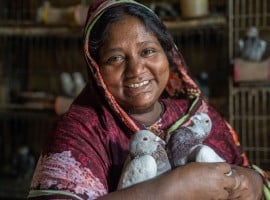
Read our 2024 annual report

Knowledge Hub
13 million people face severe hunger due to drought in Horn of Africa

Irish humanitarian organisation Concern Worldwide is responding to the Horn of Africa’s worst drought since 1981, that has left 13 million people facing severe hunger and water shortages.
Three dry rainy seasons have destroyed crops and caused widespread livestock deaths, while wells and other water sources have dried up across much of Kenya, Somalia and Ethiopia.
“Urgent help is needed in the Horn of Africa where many places have not had rain since 2020,” said Concern’s Regional Director, Amina Abdulla.
“The response across the region so far currently does not reflect the scale required to address the crisis and prevent loss of lives.
“We have in the past prevented crises like these from escalating to the point where people die from hunger and we can do this again.”
Dried up reservoirs
A drought emergency was declared in Kenya where between 80 and 90 per cent of reservoirs and dams have dried up in its largest county, Turkana, in the northwest.
Over 75,000 weak livestock are being bought and slaughtered by the Kenyan government with the meat being shared with over 766,000 households as part of its response to the crisis.
It is estimated that more than 1.4 million animals have died in Kenya alone because of the ongoing drought.
Concern is treating people showing signs of malnutrition and is also providing cash to families so they can buy food.
Repairing boreholes and wells
Its teams are also repairing broken boreholes and shallow wells and vaccinating livestock against diseases in an attempt to keep them alive during the drought.
“We are suffering the consequences of changed weather patterns caused, most believe, by climate change,” said Concern’s Kenya Country Director Arshad Muhammad.
“Food and water prices are soaring to unaffordable levels. Many herders are trekking up to 30km, which can take six days, just to find a water source.
“Vulnerable families are at risk of starvation and the most affected are children aged under-five, the elderly and breastfeeding mothers.
“It’s very worrying when even camels, known for their ability to survive in extremely hot and dry conditions, are struggling to survive.”
Hunger warning
Somalia, which has not had a normal rainy season in two years, was already ranked last on the 2021 Global Hunger Index.
“Where drought leads, hunger is never far behind,” said Concern’s Somalia Country Director, Abdi-Rashid Haji Nur.
“Water shortages are affecting huge parts of the country with an estimated 270,000 people displaced since December alone.
“Our response includes water trucking, emergency cash distributions and increasing the number of mobile medical teams we are operating in the most affected areas.”
Ethiopia
Concern said it is grateful to all Concern donors for enabling them to deliver assistance to the affected communities and welcomes a moderate scale-up in drought specific funding from the European Union and the British government.
In Ethiopia, the drought is affecting an estimated 6.8 million people and it is feared that if the fourth rainy season also fails this March and April, that the crisis will reach even greater levels.
About 5.5 million children are expected to be acutely malnourished, which can be fatal if not treated across Kenya, Somalia and Ethiopia in 2022.
For more information or interview requests please contact Kevin Jenkinson at kevin.jenkinson@concern.net or on 0863582886.
Other ways to help
Corporate support
Is your company interested in working together for a common cause?
Fundraise for Concern
From mountain trekking to marathon running, cake sales to table quizzes, there are lots of ways you can support our work.
Buy a gift
With an extensive range of alternative gifts, we have something to suit everybody.
Leave a gift in your will
Leave the world a better place with a life-changing legacy.
Volunteer with Concern
The lots of ways to get involved with our work as a volunteer
School fundraising
Without the generous support from schools, we wouldn't be able to do the work that we do.

